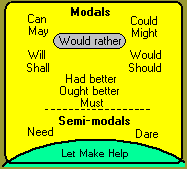Special verbs as we have seen,have a very important role in the formation of questions and negatives.Another important function of these special verbs is their use in short answers.It is not usual to give full answers to questions in English.
For Example:
If you are asked a question ,
##"Are you fond of ice-creams?" you should not say "Yes,I am fond of ice-creams" or
"No,I am not fond of ice-creams". This type of answers would be very formal and unnatural.
##You should say,"Yes,I am" or "No,I am not".
The following is the most usual form of short answers to yes-no questions.
yes+pronoun+special verb or no+pronoun+special verb+n't
Examples:
1. Have you got pencil ? {Yes,I have or No,I haven't}
2. Do you know Telugu ? {Yes,I do or No,I don't}
3.Was the train late ? {Yes,It was or No ,It wasn't}
You must have noticed that the special verb which is used in the short answer is the same verb with which the question begins.If the subject of the question is a noun, its pronoun form is used in short answers.
For Example:
If you are asked a question ,
##"Are you fond of ice-creams?" you should not say "Yes,I am fond of ice-creams" or
"No,I am not fond of ice-creams". This type of answers would be very formal and unnatural.
##You should say,"Yes,I am" or "No,I am not".
The following is the most usual form of short answers to yes-no questions.
yes+pronoun+special verb or no+pronoun+special verb+n't
Examples:
1. Have you got pencil ? {Yes,I have or No,I haven't}
2. Do you know Telugu ? {Yes,I do or No,I don't}
3.Was the train late ? {Yes,It was or No ,It wasn't}
You must have noticed that the special verb which is used in the short answer is the same verb with which the question begins.If the subject of the question is a noun, its pronoun form is used in short answers.
Link for the day :http://thegrammargang.blogspot.com/
Note: This article doesn’t covers the full scope of the above dealt topic. It is better recommended for a basic understanding only.
Happy Reading !!! Leave your valuable comments and help me grow :)
NEXT ARTICLE : VERB SERIES 5
Source : Wren and Martins' English Grammar and Composition., image source:Google.
Written by:





